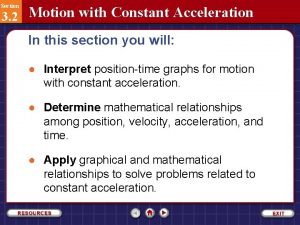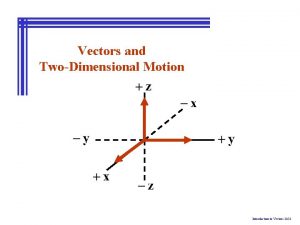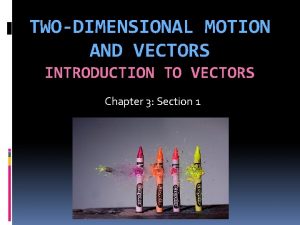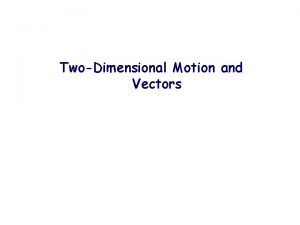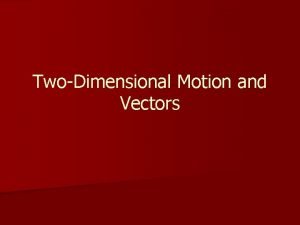TwoDimensional Motion Vectors Section 1 Introduction to Vectors









- Slides: 9

Two-Dimensional Motion & Vectors

Section 1: Introduction to Vectors & Vector Operations: Section Objectives: Distinguish between a scalar and a vector. Add and subtract vectors using the graphical method. Multiply and divide vectors by scalars. Determine resultant magnitude and direction.

Scalars & Vectors � What is a scalar? ◦ A quantity that has magnitude but no direction. What is a vector? A quantity that has both magnitude and direction. A resultant vector represents the sum of two or more vectors. Vectors can be added graphically. They can be added in any order. Multiplying or dividing vectors by scalars results in vectors.

The Pythagorean Theorem � The Pythagorean theorem can be utilized to determine the magnitude of the resultant. � c 2=a 2 + b 2 � This can be applied to any right triangle. It may also be applied to find the magnitude of a resultant displacement. � The tangent function can be used to find the direction of the resultant. � tanΘ=opposite/adjacent � The inverse tangent provides the angle, Θ. (tan-1)

Law of Cosines… � The law of cosines can be utilized to determine the magnitude of the resultant of any two angles: � R 2=A 2 + B 2 -2 AB(cosΘ)

More about vectors… Vectors can be resolved into components.

Sample Problem A: An archaeologist climbs the Great Pyramid in Giza, Egypt. The pyramid’s height is 136 -m and its width is 2. 30 x 102 m. What is the magnitude and direction of the displacement of the archaeologist after she has climbed from the bottom of the pyramid to the top? Finding resultant magnitude and direction…

Find the components of the velocity of a helicopter traveling 95 -km/h at an angle of 35° to the ground. Resolving Vectors…Sample Problem B

A hiker walks 27. 0 -km from her base camp at 35° south of east. The next day, she walks 41. 0 -km in a direction 65° north of east and discovers a forest ranger’s tower. Find the magnitude and direction of her resultant displacement between the base camp and the tower. Practice C: Adding Vectors Algebraically…
 Chapter 2 section 1 describing motion answer key
Chapter 2 section 1 describing motion answer key Chapter 2 motion section 1 describing motion answer key
Chapter 2 motion section 1 describing motion answer key Section 1 describing motion answer key
Section 1 describing motion answer key Describing motion chapter 1 lesson 1
Describing motion chapter 1 lesson 1 Motion section 1 describing motion
Motion section 1 describing motion Two dimensional motion examples
Two dimensional motion examples What is active rom
What is active rom Simple harmonic motion equation
Simple harmonic motion equation An object in motion stays in motion
An object in motion stays in motion Section 2 motion with constant acceleration
Section 2 motion with constant acceleration









